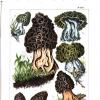
29-06-2019 06:05
 Lothar Krieglsteiner
Lothar Krieglsteiner
... found 15.3.19, National Park Monfrague, under

02-07-2019 13:36
 Blasco Rafael
Blasco Rafael
Hola, tengo esta muestra recogida sobre Rubus idae

01-07-2019 07:52
 Blasco Rafael
Blasco Rafael
Hola, tengo recogida esta orbilia de esporas renif

30-06-2019 11:03
 Zuzana Sochorová (Egertová)
Zuzana Sochorová (Egertová)
Hello, could someone send me this paper, please?G

30-06-2019 20:55
 Angel Pintos
Angel Pintos
At first I thought it was Beauveria sp, but the co

30-06-2019 23:59
 Michel Hairaud
Michel Hairaud
Bonjour , J'aimerais trouver la page 205 de :

30-06-2019 08:43
Juuso ÄikäsI found these yesterday in a wet, muddy depression

29-06-2019 14:56
Peter ThompsonHello Everyone,I have found an ascomycete which is

19-06-2019 12:19
Salvador TelloHola.Tengo estos peritecios que crecen en ramitas

... found 15.3.19, National Park Monfrague, under Arbutus and Quercus ilex some distance away, on likely quite acid soil.
The greenish tint seems distinctive. Does somebody have an idea of the species?
Unfortunately, the only one ascoma was fully unripe, even after a week of keeping (in Portugal then).
Best regards, Lothar

Hallo Martin,
vielen Dank für die interessante Tafel!
Ich denke aber, dass mein Pilz keine Speisemorchel (esculenta), sondern eher eine Spitzmorchel (elata s.l.) ist.
Bei meinen Recherchen bin ich auf M. eximioides gestoßen,die grünliche Töne haben soll, aber wohl bisher nur in Nordeuropa gefunden wurde (?).
Viele Grüße, Lothar

= Morilla villica var. virescens Quél. 1902, 496
= Morchella esculenta var. viridis (Leuba) Saccardo, Sylloge Fungorum XVIII: 2 (1906)
= Morchella esculenta (L.) Pers. 1801, (synon. in Traverso Syll. Fung. XX: 117 (1911))

Hello Martin,
yes - English is good, maybe others have to contribute.
My specimen has a clear ditch (this is a translation from the German "Graben" - I mean a cavity between the "cap" and the stem) and so should belong to the conica-goup (former Section Distantes).
You are right, the one picture of M. viridis looks similar and the actual rating as a synonym of M. esculenta does not say a lot.
So - why not M. viridis as a working name.
Best regards, Lothar

Hi Lothar and everyone,
Here is an answer from Philippe CLowez to whom I transferred the link . (his mail pharmacie.clowez@orange.fr">pharmacie.clowez@orange.fr) . Amitiés. Michel
En ce qui la morille avec des nuances vertes :
1) -Ces nuances sont caractéristiques d'un certain groupe de morilles = la stirpe inamoena-pulchella
-Le chapeau triangulaire avec peu d'alvéoles secondaires d'une hauteur sensiblement égale au chapeau va aussi dans ce sens
-L'écologie devrait être sous Populus.
-Les spores devraient être caractéristiques de grande longueur (environ 26-28 µm) avec des rainures type sillons barbelés profonds.
-Odeur de fromage ?
-Portugal = thermophile.
2) Si les spores ne sont pas cela, que l'écologie est différente, il existe une petite morille qui pourrait correspondre mais qui n'est signalée qu'à Chypre et en Grèce = Morchella disparilis.
Bien amicalement. Phil

Hello Michel,
thank you very much für your mediation.
Please say thanks to Mr. Clowez for his opinion.
Perhaps I will write him a mail.
But first my comments:
We do not remember a Populus standing near the morel - and we think we would have noted. If we once again come there, we will have a closer look, but we noticed only Arbutus and a with a bit distance Quercus ilex.
We could not see any spores, the one carpophore was (as I already wrote) fully unripe.
We do not remember a cheesy smell - but maybe it was.
The findplace is in Spain, not Portugal, and surely thermophilous.
Thanks again and best regards,
Lothar


